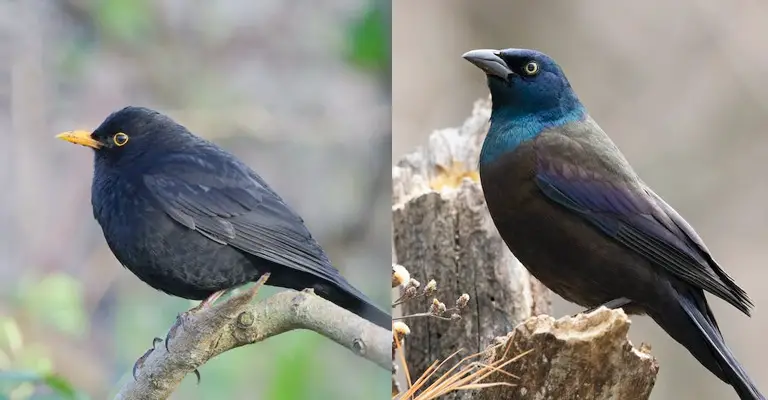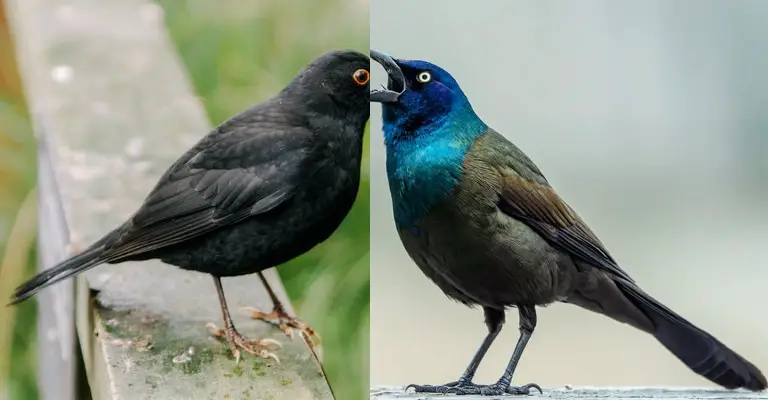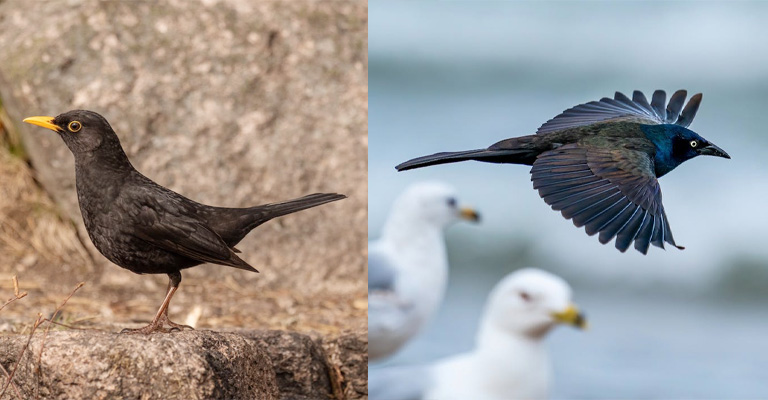When it comes to the avian world, there is no shortage of fascinating and diverse species. Among the blackbirds, two birds that often capture the attention of birdwatchers and nature enthusiasts are the Brewer’s Blackbird and the Grackle.
These avian wonders share many similarities, from their dark plumage to their foraging habits. However, they also possess distinct characteristics that set them apart.
In this introduction, we will delve into the intriguing world of Brewer’s Blackbirds and Grackles, exploring their physical attributes, habitat preferences, behaviors, and the key features that differentiate them.
By the end, you will gain a deeper understanding of these two remarkable birds and appreciate the marvels of nature that lie within each species. So let us embark on this journey to unravel the captivating tale of the Brewer’s Blackbird and the Grackle.

Physical Characteristics: Brewer’s Blackbird Vs Grackle
Birdwatching enthusiasts and nature lovers often find themselves captivated by the beauty and diversity of bird species.
When it comes to distinguishing between similar-looking birds, paying attention to their physical characteristics becomes crucial. Here are the points where Brewer’s Blackbird and Grackle have differences.
Size and Proportions
Size plays a significant role in identifying birds, and it holds true for Brewer’s Blackbirds and Common Grackles. Common Grackles tend to be larger than Brewer’s Blackbirds.
Grackles have a sleek, elongated body with a longer overall length and a more substantial build. On the other hand, Brewer’s Blackbirds are relatively smaller, with a compact body structure.
Tail Length and Shape

The length and shape of the tail can also provide valuable clues for identification. Common Grackles are known for their long, flowing tails. Their tails extend beyond the body and exhibit a graceful, tapered shape.
In contrast, Brewer’s Blackbirds have comparatively shorter tails that appear more squared off. While the tail length can vary slightly, especially during molting, observing the general shape can help distinguish between the two species.
Bill Size and Shape
The bill, or beak, is another important feature to consider. Common Grackles possess a robust and elongated bill. The bill’s length is notable, protruding prominently from the bird’s face.
In comparison, Brewer’s Blackbirds have a relatively shorter and more slender bill. While the bill shape may vary slightly among individuals, observing the overall size and proportions can aid in identification.
Head Color and Sheen
The coloration and sheen of the head provide distinct visual cues for distinguishing between Brewer’s Blackbirds and Common Grackles. Male Common Grackles exhibit a bluish sheen on their heads, creating a shimmering effect in the sunlight.
This bluish hue contrasts with the rest of their plumage. In contrast, male Brewer’s Blackbirds display a purplish sheen on their heads. This purplish coloration appears more vivid and pronounced, adding a touch of iridescence to their overall appearance.
Differences in Plumage: Brewer’s Blackbird Vs Grackle

Plumage, or the feathers covering a bird’s body, is a crucial aspect of bird identification. Brewer’s Blackbirds and Common Grackles have distinct plumage characteristics that can aid in telling them apart.
Body Color and Patterns
The body color and patterns differ between Brewer’s Blackbirds and Common Grackles. Common Grackles have predominantly black plumage, with a glossy appearance that reflects shades of purple, green, and blue in certain lighting conditions.
However, up close, their bodies may show some brown tones. In contrast, Brewer’s Blackbirds have predominantly black plumage as well, but their bodies often exhibit a deep, rich brown color, especially on their heads and backs.
This brown coloration sets them apart from the more uniformly black appearance of Common Grackles.
Wing Position and Shape
The positioning and shape of the wings can provide useful clues for identification. Common Grackles typically hold their wings in a slightly raised position when at rest, creating a noticeable gap between the wings and the tail.
This characteristic wing position gives them a sleek and streamlined look. On the other hand, Brewer’s Blackbirds often hold their wings drooped or closer to their body, without a distinct gap between the wings and the tail.
Observing the wing position can help differentiate between the two species.
Tail Appearance and Structure
The appearance and structure of the tail can also aid in identification. Common Grackles have long and flowing tails that extend beyond their body length.
The feathers of their tail display a graceful, tapered shape, resembling a wedge or fan. In contrast, Brewer’s Blackbirds have relatively shorter tails that appear more squared-off at the end.
While the tail length can vary slightly, paying attention to the general shape and proportions of the tail feathers can be helpful in distinguishing between the two species.
By considering the body color and patterns, wing position and shape, and tail appearance and structure, birdwatchers can refine their ability to identify Brewer’s Blackbirds and Common Grackles accurately.
These plumage characteristics, along with the previously discussed physical traits, contribute to a comprehensive understanding of these remarkable bird species.
Appreciating the beauty and uniqueness of their plumage adds to the joy and fulfillment of observing and identifying birds in the natural world.
Habitat and Range: Brewer’s Blackbird Vs Grackle

Brewer’s Blackbird and Grackle also share a lot of variations in their typical habitats and ranges. Here is how they have the differences.
Typical Habitats for Brewer’s Blackbird
Brewer’s Blackbirds are highly adaptable and can be found in a variety of habitats across North America. They are commonly associated with open habitats such as grasslands, agricultural fields, meadows, and pastures.
These birds are often seen in urban and suburban areas, including parks, golf courses, and even parking lots. Brewer’s Blackbirds are known to forage on the ground, searching for insects, seeds, and grains.
Their adaptability to different environments enables them to thrive in both natural and human-altered landscapes.
Typical Habitats for Common Grackle
Common Grackles also have a versatile habitat range and can be found across North America. They are often associated with wooded areas, forests, and marshes.
These birds are particularly attracted to areas near water, including wetlands, riversides, and lakeshores. Common Grackles are adaptable foragers, and their diet includes a wide range of food sources such as insects, small vertebrates, fruits, and seeds.
They are also known to exploit urban environments, including residential areas and city parks, where they scavenge for food and nest in trees and shrubs.
Geographical Range of Each Species
Brewer’s Blackbirds have a widespread distribution throughout North America. They are native to western and central parts of the continent, ranging from western Canada and Alaska down to Mexico.
They are commonly found in the western United States and can be seen as far east as the Great Plains and parts of the Midwest. Common Grackles have a broader range that extends across North America.
They are native to eastern and central regions of the continent, ranging from Canada’s Atlantic provinces and the northeastern United States down to the Gulf Coast and parts of Texas. They are also found in localized populations in the western United States.
Behavior and Vocalizations
As usual, Brewer’s Blackbird and Grackle have some specific differences in their behavior and vocalizations. Here is how they have the variations.
Feeding Behavior and Diet
Both Brewer’s Blackbirds and Common Grackles exhibit omnivorous feeding behavior, meaning they consume a wide variety of food items. They forage primarily on the ground, searching for insects, seeds, grains, fruits, and small vertebrates.
Brewer’s Blackbirds often feed in flocks, actively probing the ground for insects and seeds in open habitats. Common Grackles, on the other hand, employ different foraging strategies.
They use their long bills to probe the soil and leaf litter for invertebrates and also scavenge for food in urban areas, taking advantage of human-provided food sources.
Nesting Habits
Brewer’s Blackbirds and Common Grackles have distinct nesting habits. Brewer’s Blackbirds build their nests in a variety of locations, including trees, shrubs, and even man-made structures such as buildings and bridges.
Their nests are cup-shaped and constructed with twigs, grasses, and other plant materials. Common Grackles, on the other hand, typically build their nests in trees, usually at a greater height than Brewer’s Blackbirds.
Their nests are also cup-shaped but are often bulkier and may incorporate additional materials like mud and small branches.
Social Behavior
Both Brewer’s Blackbirds and Common Grackles are highly social birds. Brewer’s Blackbirds often gather in large flocks, especially during the non-breeding season, foraging together and roosting communally.
During the breeding season, males establish territories and engage in displays to attract females. Common Grackles also exhibit social behavior and are frequently observed in flocks.
They form complex social hierarchies within their groups, with dominant individuals occupying central positions and asserting their dominance over others.
Vocalizations and Calls
Vocalizations play a crucial role in bird communication, and both Brewer’s Blackbirds and Common Grackles have distinctive calls. Brewer’s Blackbirds have a varied repertoire of vocalizations.
Their calls include a sharp “chek” or “chuck” sound and a metallic “chur” note. Males also produce a melodious, flute-like song during the breeding season.
Common Grackles are known for their vocal nature as well. They emit a range of calls, including harsh, metallic “chack” or “chek” sounds, as well as a grating or creaking noise.
Their vocalizations can be loud and quite characteristic.
Identification Tips
Identifying these two species will be easier if you manage to follow the below tips.
Key Distinguishing Features
- Size and Proportions: Common Grackles are generally larger than Brewer’s Blackbirds, with a longer tail and a heavier bill.
- Head Color and Sheen: Male Common Grackles display a bluish sheen on their heads, while Brewer’s Blackbirds have a purplish sheen.
- Body Color: Brewer’s Blackbirds exhibit a deep, rich brown color on their heads and backs, whereas Common Grackles have predominantly black plumage with hints of purple, green, and blue in certain lighting conditions.
Visual Cues for Differentiating Between the Two Species
- Wing Position: Common Grackles tend to hold their wings slightly raised when perched, creating a gap between the wings and the tail. Brewer’s Blackbirds often hold their wings drooped or closer to their body, without a distinct gap.
- Tail Shape: Common Grackles have long, flowing tails with a graceful, tapered shape resembling a wedge or fan. Brewer’s Blackbirds have relatively shorter tails that appear more squared-off at the end.
- Bill Size and Shape: Common Grackles have robust, elongated bills, while Brewer’s Blackbirds have slightly shorter and less pointed bills.
Common Misidentifications and How to Avoid Them
- Rusty Blackbird: In certain regions, the Rusty Blackbird may be mistaken for Brewer’s Blackbirds or Common Grackles. To differentiate, note that Rusty Blackbirds have a more uniform dark brown or black plumage without the distinctive sheen seen in the other two species.
- Red-winged Blackbird: Male Red-winged Blackbirds have black plumage with red shoulder patches, which may lead to confusion. However, their smaller size, lack of sheen on the head, and distinct red shoulder patches distinguish them from both Brewer’s Blackbirds and Common Grackles.
To avoid misidentifications, it is essential to carefully observe multiple distinguishing features such as size, proportions, head color, wing position, tail shape, and bill characteristics.
Paying attention to these details and comparing them to field guides or reference materials can enhance accuracy in identifying Brewer’s Blackbirds and Common Grackles.
Similar Species and Confusing Factors
Even for professionals and elder bird enthusiasts, identifying Brewer’s Blackbird and Grackle becomes difficult because of some confusing factors and similarities. You can check out these factors to understand them well.
Other Blackbird Species That Can Be Confused With Brewer’s Blackbird or Common Grackle
- Red-winged Blackbird (Agelaius phoeniceus): Male Red-winged Blackbirds have black plumage with distinctive red shoulder patches, which can cause confusion, especially when they are seen from a distance or in poor lighting conditions.
However, their smaller size, lack of head sheen, and unique red shoulder patches can help distinguish them from Brewer’s Blackbirds and Common Grackles. - Rusty Blackbird (Euphagus carolinus): Rusty Blackbirds may be mistaken for Brewer’s Blackbirds or Common Grackles, particularly in areas where they overlap.
Rusty Blackbirds have a more uniform dark brown or black plumage without the distinctive sheen seen in the other two species. They also tend to have a lighter eye color compared to Brewer’s Blackbirds and Common Grackles.
How to Differentiate Between Similar Species
- Size and Proportions: Pay attention to the overall size and proportions of the bird. Brewer’s Blackbirds are slightly smaller than Common Grackles, while Red-winged Blackbirds are even smaller. Size comparisons can help in distinguishing between these species.
- Plumage and Head Color: Look for specific plumage characteristics, such as the presence of a sheen on the head. Brewer’s Blackbirds have a purplish sheen, while Common Grackles have a bluish sheen. Rusty Blackbirds lack this sheen, and Red-winged Blackbirds have red-shoulder patches.
- Wing Patterns and Tail Shape: Note the wing patterns and tail shape. Brewer’s Blackbirds have drooped wings and a relatively shorter, squared-off tail.
Common Grackles may show a gap between the wings and tail when perched, with a long, flowing tail. Rusty Blackbirds have wing patterns that are typically darker and lack the distinctive wedge-shaped tail seen in Common Grackles. - Habitat and Range: Consider the typical habitats and geographical ranges of each species. Brewer’s Blackbirds are commonly found in open habitats, while Common Grackles prefer wooded areas and wetlands. Rusty Blackbirds are associated with wetter habitats, such as bogs and swamps. Understanding their preferred habitats can provide additional context for identification.
By carefully considering the size, plumage characteristics, wing patterns, tail shape, and habitat preferences of these similar blackbird species, birdwatchers can make more accurate identifications and avoid potential confusion.
Consulting field guides or experienced birders can also be helpful in confirming identifications and resolving any uncertainties.
20 Differences At a Glance: Brewer’s Blackbirds Vs. Grackles
| Category | Brewer’s Blackbird | Common Grackle |
| Size | Smaller | Larger |
| Tail Length | Relatively shorter | Longer |
| Bill Size | Shorter and less robust | Longer and more robust |
| Head Color | Purplish sheen | Bluish sheen |
| Body Color | Deep brown | Predominantly black, with hints of green/blue/purple |
| Wing Position | Drooped | Held slightly raised |
| Tail Shape | Squared-off | Tapered/wedge-shaped |
| Eye Color | Yellow | Yellow/amber |
| Habitat Preferences | Open habitats (fields, grasslands) | Woodlands, wetlands, urban areas |
| Geographical Range | North America | North America, parts of Central America |
| Nesting Locations | Trees, shrubs, man-made structures | Trees, often at greater heights |
| Nest Construction | Cup-shaped with twigs, grasses | Cup-shaped with additional materials like mud, branches |
| Foraging Behavior | Ground forager | Ground forager, scavenge in urban areas |
| Feeding Preferences | Insects, seeds, grains | Insects, seeds, fruits, small vertebrates |
| Social Behavior | Flock together | Flock together, complex social hierarchies |
| Vocalizations | Sharp “chek” or “chuck” sounds | Harsh “chack” or “chek” sounds |
| Breeding Displays | Minimal displays | Elaborate displays |
| Common Misidentifications | Rusty Blackbird, Red-winged Blackbird | Rusty Blackbird, Red-winged Blackbird |
| Wing Patterns | Drooped wings | The gap between wings and tail |
| Preferred Habitats | Open fields, agricultural areas | Wetlands, marshes, suburban areas |
Faqs
Yes, both Brewer’s Blackbirds and Common Grackles can be found in urban areas. While Brewer’s Blackbirds are more commonly associated with open fields and agricultural areas, they have adapted well to urban environments, including parks and residential areas.
Common Grackles, on the other hand, are known to thrive in a variety of habitats, including urban and suburban areas, where they scavenge for food and build nests in trees and man-made structures.
Brewer’s Blackbirds are generally considered short-distance migrants, with some populations in northern regions migrating south during the winter months.
However, many Brewer’s Blackbirds are non-migratory and can be found year-round in their breeding territories. Common Grackles, on the other hand, have a diverse migration pattern.
While some populations are migratory, others may be residents or make shorter movements in response to food availability and weather conditions.
Yes, both Brewer’s Blackbirds and Common Grackles can exhibit territorial behavior, particularly during the breeding season. Male individuals of these species often defend a specific territory where they establish their nests and seek to attract mates.
They may engage in aggressive displays and vocalizations to ward off intruders and protect their territory.
Both Brewer’s Blackbirds and Common Grackles can interact with other bird species. They are known to be opportunistic feeders and may associate with mixed flocks of other blackbird species, sparrows, or starlings during foraging.
However, they can also compete with other bird species for resources and may occasionally display aggressive behavior towards them.
Conclusion
The Brewer’s Blackbird and the Grackle are two remarkable avian species that share similarities yet possess distinct characteristics.
These birds have captured the attention of birdwatchers and nature enthusiasts with their dark plumage, foraging habits, and unique behaviors.
The Brewer’s Blackbird, with its glossy black feathers and yellow eyes, thrives in a variety of habitats across North America, displaying remarkable adaptability and resourcefulness.
On the other hand, the Grackle, known for its iridescent plumage and loud vocalizations, is often found in wetland areas, demonstrating its affinity for water and marshy environments.
So, they share a lot of differences even though they look similar. Now, I think, you don’t have any problem identifying these two species. Best of luck.